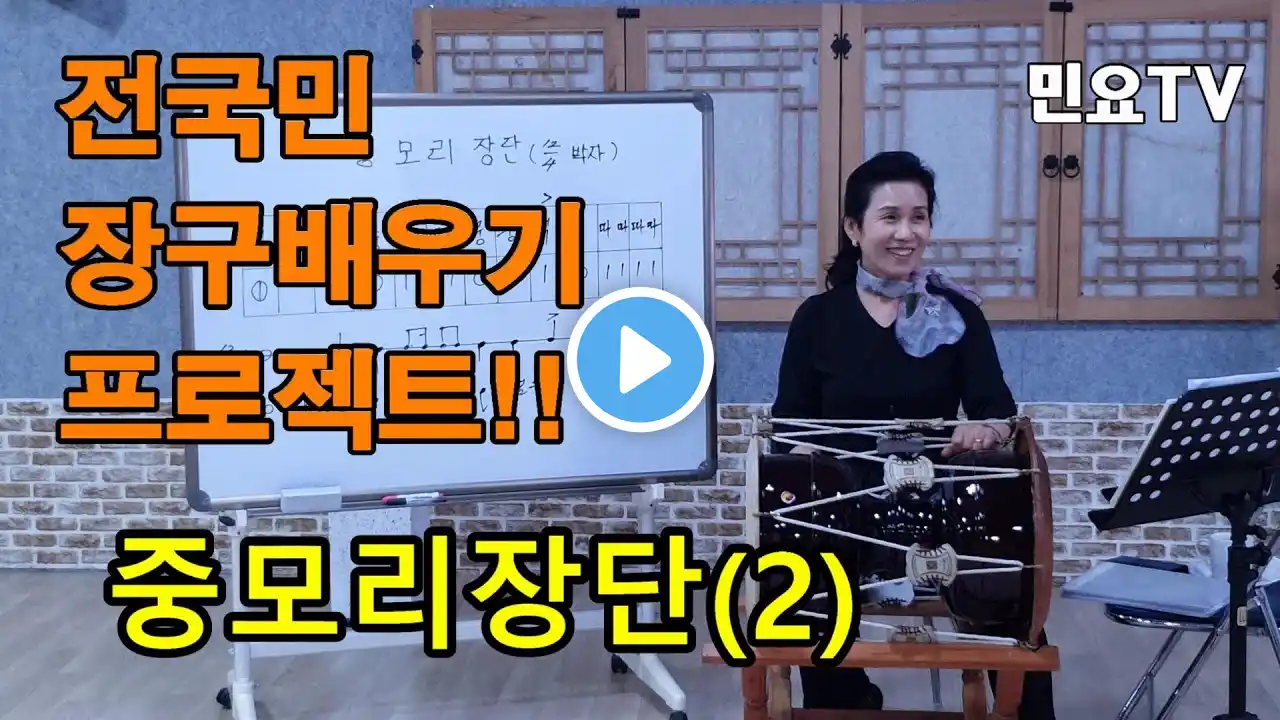
중모리장단 배우기(기본) - 금강산타령 '천하명산' l 서행복의 알기쉬운 민요반주법, Easy Korean folk song accompaniment of Seo Haeng-bok
#서행복 #중모리장단 #서행복의알기쉬운민요반주법 #금강산타령 #민요TV 전국민 민요배우기 프로젝트 '서행복의 알기쉬운 민요반주법ㅣ 중모리장단 배우기 - 금강산타령 '천하명산' : Easy Korean folk song accompaniment of Seo Haeng-bok / Jungmorijangdan 1, 韓國民謠 講習 ‘장구(Janggu)’로 민요 반주하는 방법을 ‘서행복(Seo Haeng-bok)’ 강사와 함께 배워보는 코너로 ‘중모리장단(Jungmorijangdan)’ 첫 번째 시간입니다. 중모리장단(Jungmorijangdan)은 굿거리장단(Gutgeorijangdan) 보다 조금 느린 장단(Jangdan)으로 '중모리(Jungmori)'는 '중간 속도로 몰아간다'는 뜻이다. 구음으로 하면 '덩(deong) 덕(deok) 쿵(kung) 덕 기덕덕(deok gi deokdeok) 쿵(kung) 쿵(kung) 덕(deok) 쿵(kung) 덕기덕덕(deok gi deokdeok)'이고 4분의 8박자로 되어있다. 우리 민요에서는 한오백년(Han-obaengnyeon), 몽금포타령(Monggeumpotaryeong), 금강산타령(Keumgangsantaryeong), 강강술래(Ganggangsullae) 등이 중모리장단(Jungmorijangdan)으로 되어 있다. 장단을 모르고 노래하는 것과 장구를 치면서 노래하는 것은 큰 차이가 있습니다. 어렵지만 처음부터 장구를 치면서 노래하는 습관을 들여보세요. 초보자도 계속 따라 하다 보면 누구나 민요 반주를 할 수 있으니 함께 배워보세요^^ 이 영상이 도움이 되셨다면 '좋아요(Like)'와 '구독(Subscrition)' 버튼을 눌러 주세요. '구독' 은 영상 아래 오른 쪽에 붉은 색으로 된 '구독'버튼을 누르면 됩니다. '구독' 버튼은 한번만 누르면 되고 '구독중'으로 검은색으로 바뀌며 신문 구독과 달리 돈이 빠져나가지 않으니 안심하고 누르셔도 됩니다. '좋아요'는 영상 아래 오른 쪽의 엄지척 모양을 누르시면 됩니다. 이 영상을 영상 아래 오른 쪽의 '공유' 버튼을 눌러서 각자의 카톡이나 페이스북, 카페 등으로 공유할 수 있습니다. '좋아요'와 '구독' 및 '공유'는 동영상을 제작하는데 큰 도움이 됩니다. 민요 장구 강습문의 : 한국국악교육원(韓國國樂敎育院, Korean Traditional Music Center) T.02-394-3480, 010-5232-3834, 서울 강북구 도봉로 150, 창림빌딩 5층 민요TV 후원하기 : 농협 013-01-300057, 한국국악교육원 (후원금은 민요TV의 더 좋은 콘텐츠제작을 위해 사용됩니다) 교재 구입하기 : 15,000원(발송비 포함), 농협 013-01-300057, 한국국악교육원 (입금 후 02-394-3480로 전화요망, 입금 시는 꼭 본인 이름으로 입금해 주세요) 강사 서행복 약력 전숙희명창 경기민요 사사 원광디지털대학교 전통공연예술학과 졸업 진주교육대학교 교육대학원 석사과정 맹사성전국국악경연대회 대상 대한민국연예대상 국악공로상 대한민국국악대상 대상 현재 / 한국국악교육원 부원장 강북국악예술단 단장 민요TV 구독하기 https://www.youtube.com/channel/UCiAS... 페이스북(서행복) / seohappy 블로그(서행복의 민요이야기) http://blog.daum.net/seohappy/?t__nil 유튜브(한국국악교육원TV) https://www.youtube.com/channel/UC3fD.... It's the first part of Jungmorijangdan where you learn how to perform folk songs with Janggu with a teacher named "Seo Haeng-bok." Jungmorijangdan is a bit slower than the Gugeorijangdan, which means "Jungmori drives at medium speed." In the spoken word, it is "Deok Deok," "Kung Deok Deokdeok," "Kung" and "Deok Gi Deokdeok" and "Deok Gi-deok, "Deok Gi-deok" and "Deok Gi-deok." In our folk songs, Han-obaengnyeon, Monggeumpotaryeong, Keumgangsantaryeong and Ganggangsullae are composed of Jungmorijangdan. If you keep following the beginner, everyone can perform folk songs. Learn with them.^^ If this video is helpful, please press the "Like" and "Subscription" buttons, and if you have anything you want to say, please leave a comment. I'll reflect your suggestions in the video production as much as possible. Thank you. Korean Traditional Music Center T.02-394-3480, Dobong-ro 150 in Gangbuk-gu, Seoul, 5F Changlim Building Trainer(s) to wear slow clothes Jeon Sook Hee-chang, Gyeonggi Min-yo, Sasa Graduated from the Department of Traditional Performing Arts at Wonkwang Digital University Master's course at the Graduate School of Education at Jinju National University of Education Subject to the Maeng Sa-sung National Gugak Competition Gugak Achievement Award for the Korean Performing Arts Target of the Korean Traditional Music Awards Current / Deputy Director of the Korean Traditional Music Education Center Director of the Gangbuk Gugak Art Troupe Facebook (success) / seohappy Blogs (Many of Happiness) http://blog.daum.net/seohappy/?t__nil YouTube (Korea Institute of Gugak Education TV) https://www.youtube.com/channel/UC3fD...
